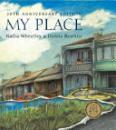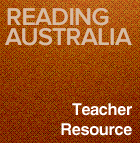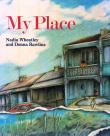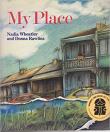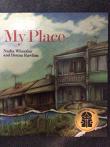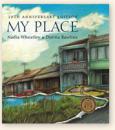AustLit
Latest Issues
AbstractHistoryArchive Description
'My Place, the classic Australian picture book, is a "time machine" which takes the reader back into the past. It depicts the history of one particular piece of land in Sydney from 1788 to 1988 through the stories of the various children who have lived there. It aims to teach the reader about the history of Australia, about families, settlers, multiculturalism, and the traditional owners of the land. Each child's story covers a decade in time, showing their particular dress, customs and family life.
'The book also features maps that the successive generations of children have 'drawn' which demonstrate the things that have changed - as well as the things that have remained constant. My Place ultimately aims to show "that everyone is part of History" and that "every place has a story as old as the earth".' -- Provided by publisher (2008 ed.)
Adaptations
-
form
y
 My Place
( dir. Shawn Seet
et. al. )agent
Australia
:
Little Leaf Pictures
Matchbox Pictures
ABC Television
,
2009-2011
Z1649817
2009-2011
series - publisher
film/TV
children's
historical fiction
My Place, based on the award-winning book My Place by Nadia Wheatley and Donna Rawlins, is a thirteen-part drama series that tells the story of one house in South Sydney through the experiences of the children who live there over a 130-year period. My Place aims to show that everyone is part of history and that every place has a story.
My Place
( dir. Shawn Seet
et. al. )agent
Australia
:
Little Leaf Pictures
Matchbox Pictures
ABC Television
,
2009-2011
Z1649817
2009-2011
series - publisher
film/TV
children's
historical fiction
My Place, based on the award-winning book My Place by Nadia Wheatley and Donna Rawlins, is a thirteen-part drama series that tells the story of one house in South Sydney through the experiences of the children who live there over a 130-year period. My Place aims to show that everyone is part of history and that every place has a story.
-
form
y
 My Place Series One
( dir. Jessica Hobbs
et. al. )agent
2009
8891658
2009
single work
film/TV
My Place Series One
( dir. Jessica Hobbs
et. al. )agent
2009
8891658
2009
single work
film/TV
'My Place, the much loved Australian children's classic, tells the story of the children who live in one place over 130 years. In Volume One, meet Laura who's struggling to own up to her actions. It's 2008 and the Prime Minister is trying to do the same with her mob. Mohammed is into cricket, when he can't join the boys' team he ends up on the girls' side and they're a force to be reckoned with. ' (Source: TROVE)
-
form
y
 My Place : Series Two
( dir. Rachel Ward
et. al. )agent
2011
8891899
2011
single work
film/TV
My Place : Series Two
( dir. Rachel Ward
et. al. )agent
2011
8891899
2011
single work
film/TV
The story of one place on earth told by the children who live there from 1878 to before white settlement. The second part of MY PLACE, the series is based on the Nadia Wheatley/ Donna Rawlins book. (Source: Screen Australia website)
Reading Australia
Publication Details of Only Known VersionEarliest 2 Known Versions of
Other Formats
- Braille.
- Large print.
Works about this Work
-
Visions and Values : The Children’s Book Council of Australia’s Prizing of Picture Books in the Twenty-First Century
2016
single work
criticism
— Appears in: Canon Constitution and Canon Change in Children's Literature 2016; (p. 205-221)'The Children’s Book Council of Australia (CBCA) administers the oldest national prize for children’s literature in Australia. Each year, the CBCA confers “Book of the Year” awards to literature for young people in five categories: Older Readers, Younger Readers, Early Childhood, Picture Books and Information Books. In recent years the Picture Book category has emerged as a highly visible space within which the CBCA can contest discourses of cultural marginalization which construct Australian (‘colonial’) literature as inferior or adjunct to the major Anglophone literary traditions, and children’s literature as lesser than its adult counterpart. The CBCA has moved from asserting its authority by withholding judgment in the award’s early years towards asserting expertise via overtly politicized selections in the twenty-first century. Reading across the CBCA’s selections of picture books allows for insights into wider trends in Australian children’s literature and culture, and suggests a conscious engagement with social as well as literary values on the part of the CBCA in the twenty-first century.'
-
y
 My Place for Teachers
Australian Children's Television Foundation
,
Education Services Australia
,
2015
8891508
2015
website
children's fiction
My Place for Teachers
Australian Children's Television Foundation
,
Education Services Australia
,
2015
8891508
2015
website
children's fiction
'On this website you will find rich educational material to support primary and lower-secondary teachers using the My Place TV series in the classroom. Explore background information, aligned with the My Place stories, on events and people significant to Australia's history. Download clips and stills from the TV series, as well as teaching activities and student activity sheets that relate to current themes. Go behind the scenes with production information and interviews, or chat with other teachers and share stories in the teacher's forum.' (Source: My Place website)
-
Welcoming Back Old Friends : Re-Discovering Favourite Picture Books
2011
single work
criticism
— Appears in: Magpies : Talking About Books for Children , November vol. 26 no. 5 2011; (p. 18-21) -
My Place by Nadia Wheatley and Donna Rawlins : From Book to the Small Screen
2010
single work
criticism
— Appears in: Magpies : Talking About Books for Children , May vol. 25 no. 2 2010; (p. 20-21) Discusses the adaptation for the television series. -
Capturing 100 Years of Local History
2009
single work
column
— Appears in: The Age , 3 December 2009; (p. 12-13)
-
[Review] My Place
2008
single work
review
— Appears in: Magpies : Talking About Books for Children , September vol. 23 no. 4 2008; (p. 32)
— Review of My Place : The Story of Australia from Now to Then 1987 single work picture book -
[Review] My Place
2008
single work
review
— Appears in: Buzz Words , 15 October no. 45 2008; (p. 36-37)
— Review of My Place : The Story of Australia from Now to Then 1987 single work picture book -
First-Time Storyteller Makes the Big Time
1988
single work
review
— Appears in: The Age , 20 August 1988;
— Review of So Much to Tell You 1987 single work novel ; Crusher is Coming! 1987 single work picture book ; My Place : The Story of Australia from Now to Then 1987 single work picture book ; Deezle Boy 1987 single work novel ; The Long Red Scarf 1987 single work picture book ; Where the Forest Meets the Sea 1987 single work picture book -
Nude Boy in Cover-Up
1988
single work
review
— Appears in: The Weekend Australian , 2-3 April 1988;
— Review of Where the Forest Meets the Sea 1987 single work picture book ; So Much to Tell You 1987 single work novel ; Pheasant and Kingfisher 1987 single work picture book ; The Long Red Scarf 1987 single work picture book ; The Landing : A Night of Birds 1987 single work children's fiction ; Deezle Boy 1987 single work novel ; My Place : The Story of Australia from Now to Then 1987 single work picture book ; Digging to China 1988 single work picture book ; Obernewtyn 1987 single work novel ; A Paddock of Poems 1987 selected work poetry ; Looking Out For Sampson 1987 single work children's fiction ; The Makers 1987 single work novel ; Birk, the Berserker 1987 single work children's fiction ; Tucking Mummy In 1987 single work picture book -
And the Winners Are!
1988
single work
review
— Appears in: The Weekend Australian , 20-21 August 1988; (p. 14)
— Review of So Much to Tell You 1987 single work novel ; Where the Forest Meets the Sea 1987 single work picture book ; I Am Susannah 1987 single work novel ; Crusher is Coming! 1987 single work picture book ; The Long Red Scarf 1987 single work picture book ; Deezle Boy 1987 single work novel ; My Place : The Story of Australia from Now to Then 1987 single work picture book -
Know the Author : Nadia Wheatley
1988
single work
column
— Appears in: Magpies : Talking About Books for Children , September vol. 3 no. 4 1988; (p. 16-17) -
Eating Bananas Underwater
1989
single work
criticism
— Appears in: Magpies : Talking About Books for Children , July vol. 4 no. 3 1989; (p. 5-10) -
y
 Developing a Hungry Eye : Evaluating the Visual Narrative in Australian Children's Picture Books
Bruce
:
2004
Z1133200
2004
single work
thesis
During the period studied in this thesis, 1970-1999, picture books in Australia have become increasingly sophisticated and complex. In order to decode them readers need higher levels of visual literacy. In researching this the author has created a framework for evaluating visual narrative structure in picture books. This was then developed and tested on a total of 145 Australian picture books, with special focus given to the works of Ron Brooks, Dick Roughsey and Percy Trezise, Mem Fox, Donna Rawlins, Gary Crew and Bob Graham.
Developing a Hungry Eye : Evaluating the Visual Narrative in Australian Children's Picture Books
Bruce
:
2004
Z1133200
2004
single work
thesis
During the period studied in this thesis, 1970-1999, picture books in Australia have become increasingly sophisticated and complex. In order to decode them readers need higher levels of visual literacy. In researching this the author has created a framework for evaluating visual narrative structure in picture books. This was then developed and tested on a total of 145 Australian picture books, with special focus given to the works of Ron Brooks, Dick Roughsey and Percy Trezise, Mem Fox, Donna Rawlins, Gary Crew and Bob Graham.
-
The Moral Stance in the Books of Paterson and Wheatley
1989
single work
criticism
— Appears in: Magpies : Talking About Books for Children , September vol. 4 no. 4 1989; (p. 5-9) Dr. Veronica Brady talks about the moral and ethical stance of American author Katherine Paterson and Australian author Nadia Wheatly as seen in their works. -
Cultural Explorations of Time and Space : Indigenous Australian Artists-in Residence, Conventional Narratives and Children's Text Creation
2006
single work
criticism
— Appears in: Papers : Explorations into Children's Literature , December vol. 16 no. 2 2006; (p. 138-144) Zeegers is concerned with a project funded by the University of Ballarat (Victoria) and the current state of affairs whereby 'the land occupied by the school is owned by the state and notionally by the school community' (138). For Zeegers, the school community often has '...no sense of how relationships with the land may go well beyond concepts of ownership' and she perceives problems with acknowledging traditional land ownership by certain schools in certain environments.(p.138). At the time of writing, the article refers to a specific project (yet to be concluded) and aims to contribute to the project by looking at two Indigenous texts, My Place (Wheatley) and Who am I ? The Diary of Mary Talence (Heiss) analysing what perspectives they offer child readers as a 'means of access to other discourses of history' (p.142). Zeegers contends that 'the project enables both Indigenous and Non-indigenous Australian children to engage with non print based texts derived from a cultural tradition that is different from the Euro cultural tradition' (143).
Awards
- Sydney, New South Wales,
- Bush,
- Urban,
-
cAustralia,c
- 1700-1799
- 1800-1899
- 1900-1999

